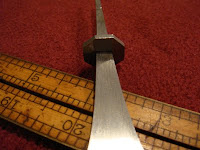Cool fall weather makes me think of two things, being able to work in the shop without sweating and football. Specifically fantasy football. I'm in three leagues again this year and am defending champ in my big money league. Our draft is tonight and I wanted to add a little something in addition to the cash prize, a trophy to be presented to the champion of the league for him to hold for the year. This is what I came up with. Not exactly original, but pretty cool I think. It's based on the Lombardi trophy, given to the NFL Super Bowl Champ. My version is, not surprisingly, made of wood. It started out as 4 pieces of construction grade yellow pine 2 x 6's laminated together for the base and 4 pieces of construction grade 2 x 6 mystery wood from my local Lowes laminated together for the football shaped object on top. Once the laminations dried, the base was laid out as a tapering triangle shaped obelisk type thing and sawn to shape with a 5 point rip saw. The football was laid out on all four sides and then sawn, chopped and finally sanded to shape. I had illusions of doing this entire project with hand tools but soon found out that was beyond my skill range. There was a LOT of work on the belt sander required to get that thing into football shape. The other tough thing was getting the top of the base scooped out so that it cradled the football without having major gappage in that connection. I did this with a variety of carving tools, scooping and fitting and scooping and fitting and scoop..........well, you get the idea. A time consuming process to say the least. Once the two pieces were glued together and the glue dried, I did some final sanding and then sprayed the whole thing with a couple coats of a copper color "hammered" paint. This gave it a pretty cool finish.





I learned a lot from this project. Number one, I don't miss using power tools. The shop was in a fog the whole time I was sanding the football to shape and when all was said and done everything in the shop was covered in a layer of saw dust. Number two, southern yellow pine has got to be one of the worst woods to carve. Those rings of resin are incredibly hard. And finally, I learned that this will be the ONLY Lombardi trophy I ever make. :) What a PITA it was. But now that it's all done, I'm glad I made it. And knowing how much work went into this damn thing will give me that much more incentive to win the league and hold on to the trophy for another year. Wish me luck in the draft!























